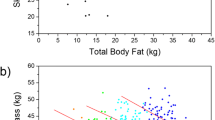Abstract
An interactive computer program, the Body Image Testing System (BITS), was developed to assess different components of the body image construct. The BITS program displays a frontal and side view of a human body. Subjects can change the size of each of nine body parts independently (face, neck, shoulders, arms, chest, breasts, stomach, hips, and thighs). Subjects interact with the program until satisfied that the image created matches the instructions. Subjects also provide satisfaction ratings for the nine body segments. To validate BITS, a variety of body image and eating disturbance measures was obtained from over 500 subjects. A factor analysis of actual-ideal differences and a perceptual distortion measure, derived using multiple regression, resulted in five orthogonal factors. Factor 1 measured actual-ideal discrepancy for weight-sensitive body parts. Factor 2 measured the perceptual distortion of weight-sensitive body parts. Additional factors measured perception of face and neck, shoulders, and breasts. The five factor scores plus the satisfaction ratings were strongly associated with actual body size, body fat percentage, and circumference of specific body parts. In addition, there were strong associations between the BITS and other measures of body image. Finally, BITS scores accounted for between 15 and 60% of the variance in measures of eating disturbance.
Similar content being viewed by others
References
Abelson, R., & Black, J. (1986). Introduction. In J. Galabamos, R. Abelson, & J. Black (Eds.),Knowledge structures. Hillsdale, NJ: Lawrence Erlbaum.
Anderson, J. (1985).Cognitive psychology and its implications (2nd edition.). New York: W. H. Freeman.
Askevold, F. (1975). Measuring body image.Psychotherapy and Psychosomatics, 26, 71–77.
Barrios, B. A., Ruff, G., & York, C. (1989). Bulimia and body image: Assessment and explication of a promising construct. In W. G. Johnson (Ed.),Advances in Eating Disorders, Vol II. New York: JAI Press.
Bell, C., & Schlundt, D. G. (1991).Mapping body image schemas. Washington, DC: Society for Behavioral Medicine, March, 1991.
Cash, T. F., & Brown, T. A. (1987). Body image in anorexia nervosa and bulimia nervosa: A review of the literature.Behavior Modification, 11, 487–521.
Cash, T. F., & Green, G. K. (1986). Body image and body weight among college students: Perception, cognition, and affect.Journal of Personality Assessment, 50, 290–301.
Cash, T. F., & Pruzinsky, T. (1990).Body images: Development, deviance, and change. New York: Guilford Press.
Collins, J. K. (1987). Methodology for objective measurement of body image.International Journal of Eating Disorders, 6, 393–399.
Cooper, P. J., Taylor, M. J., Cooper, Z., & Fairburn, C. G. (1987). Development and validation of the body shape questionnaire.International Journal of Eating Disorder, 6, 485–494.
Gardner, H. (1985).The mind's new science. New York: Basic Books.
Garner, D. M., & Garfinkel, P. E. (1979). The eating attitudes test: An index to the symptoms of anorexia nervosa.Psychological Medicine, 11, 263–284.
Garner, D. M., & Garfinkel, P. E. (1981). Body image in anorexia nervosa: Measurement, theory, and clinical implications.International Journal of Psychiatry in Medicine, 11, 263–284.
Garner, D. M., Olmstead, M. P., & Polivy, J. (1983). Development and validation of a multidimensional eating disorder inventory for anorexia and bulimia.International Journal of Eating Disorders, 2, 15–34.
Garner, D. M., Garfinkel, P. E., & Bonato, D. P. (1987). Body image measurement in eating disorders.Advances in Psychosomatic Medicine, 17, 117–133.
Hawkins, R. C., & Clement, P. F. (1980). Development and construct validation of a self-report measure of binge eating tendencies.Addictive Behaviors, 5, 219–226.
Markus, H. (1977). Self-schemata and processing information about the self.Journal of Personality and Social Psychology, 35, 63–78.
Rosen, J. C. (1990). Body-image disturbance in eating disorders. In T. F. Cash & T. Pruzinsky (Eds.),Body images: development, deviance, and change (pp. 190–216). New York: Guilford Press.
Ruff, G., & Barrios, B. (1986). Realistic assessment of body image.Behavioral Assessment, 8, 237–252.
Schlundt, D. G., & Johnson, W. G. (1990).Eating disorders: Assessment and treatment. Boston: Allyn and Bacon.
Schlundt, D. G., & Zimering, R. T. (1988). The dieter's inventory of eating temptations: A measure of weight control competence.Addictive Behaviors 13, 151–164.
Secord, P., & Jourard, S. (1953). The appraisal of body cathexis and the self.Journal of Consulting and Clinical Psychology, 17, 343–347.
Sementilli, M. E., Bell, C., Morey, L., & Schlundt, D. G., (1991).Development of the body image situational questionnaire. Washington, DC: Society for Behavioral Medicine.
Slade, P. (1985). A review of body image studies in anorexia nervosa and bulimia nervosa.Journal of Psychiatric Research, 19, 255–265.
Smith, M. C., & Thelen, M. H. (1984). The development and validation of a test for bulimia.Journal of Consulting and Clinical Psychology, 52, 863–872.
Stunkard, A. J., & Messick, S. (1985). The three-factor eating questionnaire to measure dietary restraint, disinhibition, and hunger.Journal of Psychosomatic Research, 29, 71–83.
Thompson, J. K. (1990).Body image disturbance: Assessment and treatment. New York: Pergamon Press.
Williamson, D. A. (1990).Assessment of eating disorders: Obesity, anorexia, and bulimia nervosa. New York: Pergamon Press.
Williamson, D. A., Kelley, M. L., Davis, C. J., Ruggiero, L., & Blouin, D. C. (1985). Psychopathology of eating disorders: A controlled comparison of bulimic, obese, and normal subjects.Journal of Consulting and Clinical Psych ology, 53, 161–166.
Author information
Authors and Affiliations
Rights and permissions
About this article
Cite this article
Schlundt, D.G., Bell, C. Body Image Testing System: A microcomputer program for assessing body image. J Psychopathol Behav Assess 15, 267–285 (1993). https://doi.org/10.1007/BF01371383
Accepted:
Issue Date:
DOI: https://doi.org/10.1007/BF01371383




